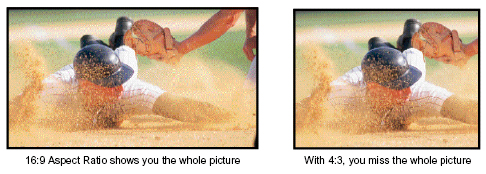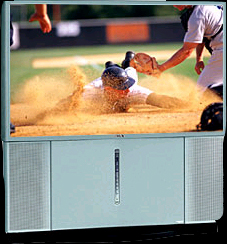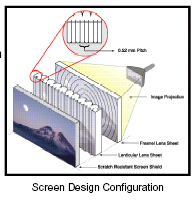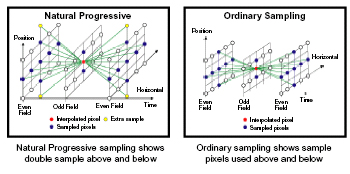(This format is no longer being sold with new models starting 2009)
|
HDTV Rear Projection Television (CRT Technology) (Discontinued Technology. Replaced by DLP Rear Projection)
When the concept of projection televisions first became popular in the 1980's, television technology was based on the standard Cathode Ray Tube technology (CRT) that had been around at the time for more than 30 years. However, while these smaller CRT's were similar in concept to the CRT's used in everyday television sets, they were different, requiring an innovative cooling method that would allow three CRT's to be driven to produce the needed additional brightness for creating a usable picture that has to be reflected off a large rear mirror and onto a etched viewing screen to be seen. A Rear-Projection System uses three small-sized CRT's, each transmitting a different color; one for red, one for green, and one for blue. These three CRT's must provide the brightness necessary to compensate for the light lost when projecting an image onto a screen. That is why larger HDTV Direct-View CRT televisions are different than rear-projection CRT's, the Direct-View set projecting the image directly onto the CRT's inside glass surface, while the rear-projection format's CRT's must shine up onto a rearview fixed mirror and then onto two etched 16:9 aspect ratio screens. If you are interested in how the rear-projection technology generates color, continue reading. If not, scroll down to move past this how it works section. ____________________________________
How It Works
Rear-projection CRT's are coupled with light magnifying lens that projects three colors onto a fixed-rear mirror that then reflects its light onto the rear of a wide-screen surface. When driven by a video processing circuitry that blends the three colors into a television image, these CRT's can produce excellent HDTV high-resolution color images. (See Chapter 1 for more information on the basic operation of a CRT tube.) The size and placement of the rear mirror determines the image size on the screen, with the CRT tubes looking up through their associated lenses, the entire assembly with electronics located at the bottom of the chassis (see drawing on left.) The image is arranged so that when it is projected on the inside rear of the screen, it has been converged for correct left-to-right viewing.
Rear-projection screens are usually made up of an inner Fresnel surface that magnifies and spreads the image across the screen. If you've seen older rear projection screens with circles that start in the middle and radiate out, you've seen a Fresnel screen (.pdf file.) (Note: The Fresnel lens was originally invented to spread the light out for ships at sea seen from the top of a lighthouse, several lens housed in a rotating structure.) Today's newer screens also include an outer lenticular surface (see drawing on right) to ensure the integrity of the image as well as the deep contrast and the faithfulness of the picture across the entire width of the screen. These lenticular etched outer screens must NEVER be cleaned with Windex or any ammonia-based cleaner, as their effectiveness will be compromised. To clean the outer surface, simply use a solution of vinegar and water (or whatever the manufacturer recommends), gently wiped with a soft cotton cloth that will not leave any cloth residue behind or scratch the screen's surface. Minimal wide-angle rear-projection screens start at around 41-inches diagonal up to around 60-inch diagonal screens. Screens beyond these sizes that include 120-inch diagonal surfaces are too large for in-house sets, and are created using three- or one-tube ceiling projectors that send their images onto a large wall screen specially sprayed or painted with a reflective material that will bounce back as much light as possible to the viewer. So in the case of rear-projection television, an image does not need to be created by beams hitting specific phosphorous pixels on a glass surface as in a Direct-View set. Instead, they create an image by mixing three colors onto the rear of the projector's wide-screen via a reflective mirror. I believe, for those who want a value-added HDTV system at a very affordable price with a screen size larger than 50-inch diagonal, the CRT-based video projection format is their best economic option. It provides one of the finest systems for displaying a true 1080i HDTV image while including a built-in stereo amplifier, a full-range four-speaker system, and a built in HDTV-ready cable tuner.
And as mentioned previously, CRT-based rear-projection technology produces some of the clearest blacks of all the formats. In the case of CRT transmissions, black is the total absence of light because there is zero energy available to produce any color on the surface of each projecting CRT. And they also give a full-range of color and brightness that is activated by an electronic beam, being also a faithful format in reproducing the unlimited gray-scales expected from motion-picture film. Wide-screen sets, like rear-projection sets, also can use a technique referred to as doubling, which allows standard television pictures to be enlarged while hiding annoying scan lines that could be seen when enlarging the NTSC scanned television image. In addition, since rear-projection television is already an established format that has been around for decades, research and develop costs do not influence the price, making rear-projection HDTV wide-screen televisions the most inexpensive on the market while providing a brilliant and HDTV high-resolution picture that is outstanding by any standard. ____________________________________
51-inch diagonally measured sets have a street price of about $1,800, while 65-inch diagonal sets run about $2,300, thousands of dollars cheaper than current LCD's, DLP's, and Plasma television formats. Their main disadvantage is the weight of the unit (though many are easy to push around a room when on large castors), along with the footprint, though it is thinner than previous older models. And of course, they cannot be hung on a wall and must remain on the floor. When and if picture tube replacement is necessary, remember it is sort of like buying new car tires, meaning if you replace one you must replace all three of them to enable equal brightness, convergence, and intensity of all three colors. And since there are three tubes, these sets must be handled very carefully when moved from different locations, the convergence of any of the three tubes could be moved out of alignment. This misalignment can cause images on the screen to have edges in one of three single colors, the set referred to as being out-of-convergence. However, it can be realigned perfectly by a qualified technician. Some rear-projection sets even have an automatic convergence feature that allows the set after aging to try to converge itself. Sony's new model even allows the convergence to be adjusted across the screen using the consumer's remote control. New rear-projection sets are very bright to begin with, their brightness control set at about 50% when delivered to the home. Therefore, the CRT tubes are running cooler to start with and are ready to provide plenty of range to increase the brightness as they age. You should never need to drive the brightness control of any rear-projection set to 100%. If you do, it is a signal the tubes will eventually need to be replaced. However, special liquid gels help keep these CRT's cool, putting off that day for many years to come. For the manufacture of these special CRT's, many manufacturers use a combination of a glass and acrylic-based configuration for their lens construction. When looking for a rear-projection television, ask about the lens types and its benefit to increasing the life of the CRT's. And when comparing sets, look at the actual picture detail on the screen using an identical picture source checking image quality, contrast, overall picture, and convergence from edge to edge. Also check the brightness level at the same time, a graph generated by a setup menu. If it's high or at full max, move on to another model or manufacturer. If you're concerned with tube replacement costs, it would be smart for you to pick up an extended four-year or five-year contract. The few hundred dollars this will add to the cost of the set will pay you back several times over if any CRT replacement is needed during the warranty period. And you'll still be far below the cost of a flat-screen TV, which still could require an add-on tuner or stereo system if not built-in. Finally, if you're age is in your forties, you might remember the early and first video game called "Pong," as mentioned in a previous chapter and worth mentioning here again, which was manufactured by Magnavox in the mid 1970's. You'll remember my saying everyone loved the new concept that created the simplest of video games, Ping-Pong. The game provided a bright wide vertical white line at the center of the screen to represent the net. People would play the game for hours, weeks at a time, before getting bored and putting the game permanently into the garage-sale closet. But after they had played the games for months, they noticed that the net line on the screen was staying there even when the game was disconnected, seen as a ghost when a normal broadcasts was being watched. This problem can be accented with a rear-projection television, the three CRT's running so bright, if an image does not move for some time on the CRT's surface, it would speed up the life of the phosphorous pixels that formed the net, causing them to later not glow as bright as the others, and hence the faded image positioned at the same exact spot on the viewing screen no matter what was being watched. This would provide the effect of a a slight hint of a line always on the screen when the television was on. Technicians called this effect a burn-in, because the image looked burned into the CRT's face when projecting images. Consumers called it lousy. But that's not the end to the story with today's images on cable. This ghosting can still be caused by single cable channels that are watched most of the time on a projection television by the user, the channel's logo always in the same spot on the screen such as with CNN, CNBC, MSNBC, Fox News Channel or Sci-fi Channel, and others with the logo slowly becoming permanently part of the screen's image like a ghost. While this ghosting can take a long time to develop, diverse viewing of movies, cable channels, and sports channels will eliminate any burn-in problems. Finally, one of the benefits of a HDTV, rear-projection wide-screen television is that it has room for an excellent built-in stereo system including amplifier, high-range, midrange, and bass speakers that are mounted and stored within its base. Unlike LCD, DLP, and Plasma formats, not only is the rear-projection format very economical, but when considering its built-in stereo amp with speakers and a HDTV cable-ready tuner, it's an excellent value. To remind you again, when you choose other flat-screen formats that hang on the wall, unless you already own a home stereo with audio input jacks, you may still have to add one to the price of your HDTV wide-screen set purchase along with a HDTV cable-ready tuner. These audio systems start at around $400 for the smallest, going up to over $2,000 and more for more powerful Dolby 5.1, 6.1, and 7.1 models. There is one downside you have to consider when purchasing a rear-projection HDTV television set. When compared to other formats, the rear-projection set has a 120-degrees viewing angle where the brightness is relatively always consistent, where LCD, Plasma, and DLP HDTV sets can reach 160 degrees or more, and depending on the manufacturer. So if you're expecting a lot of people in the room for a weekend basketball, football, baseball, or hockey game, and some viewers are going to have to sit way to the side of the screen. . . the rear-projection set just might not cut it for you. For all other applications, the 120-degree viewing angle
is probably just fine. However, as the other flat-screen technologies
bring out larger screen sizes for lesser price points matched to better
priced midrange add-on audio systems, the CRT rear projection sets
with built-in stereo systems is expected to rapidly drop as consumers
move to other formats as they drop in the price, enjoying the smaller
footprints, or if hung on the wall, nonexistent. Therefore, look for
excellent prices for CRT rear-projection televisions as the format
is phased out around 2009, retailers moving the dying format out the
door. That will be the same year television broadcasters will shut
out the lights for NTSC, making it into a museum piece and thanking
the former television standard for its 60 years of outstanding service. ___________________________________ ___________________________________
|
|
Index
|




